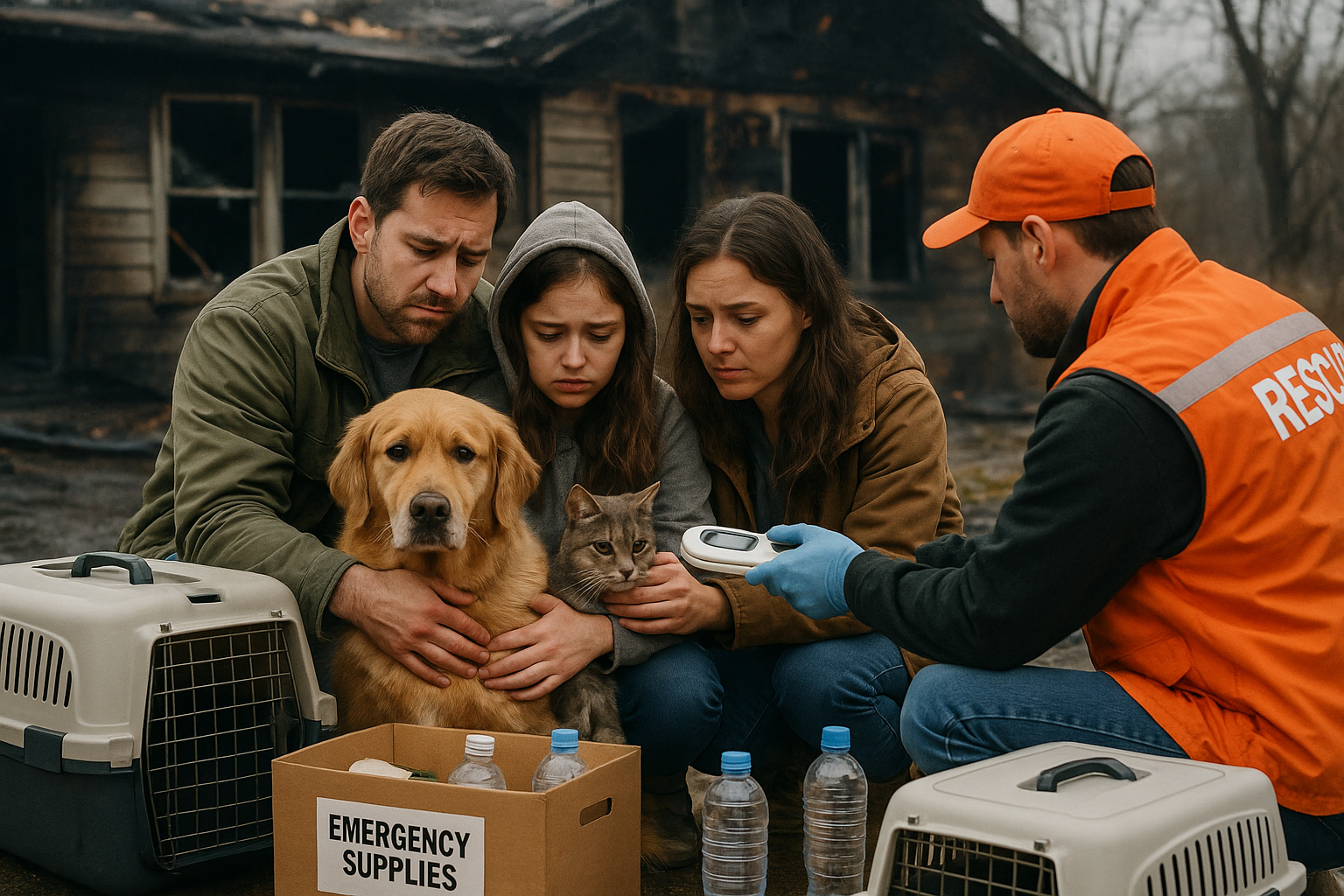Disasters change lives in an instant. Pets feel that upheaval just as deeply as their people. Floods, fires, or storms can put furry family members in harm’s way. Pet disaster preparedness helps reduce panic, limit loss, and keep dogs, cats, and smaller creatures safe throughout the process. When chaos strikes, quick thinking combined with careful planning makes recovery faster and less stressful for everyone.
Building a Pet Disaster Plan That Works
Advance planning can mean the difference between safety and separation. Start with pet identification. Collars with ID tags give first responders the quickest direction to reunite you with your pet if they escape. Include your current number, address, and the pet’s name on every tag. Microchipping gives an added layer of security if tags break or become unreadable. Many humane societies can quickly scan and match a chip to their registration database, allowing for lost pet recovery long after a disaster ends.
Create a written disaster plan for your household. List all pets, their descriptions, medical needs, and preferences if relevant. Keep a recent clear photo of each animal on your phone. Share your plan with household members and a trusted emergency contact outside your home area, such as a family member or friend. Assign responsibilities to each adult, so no pet is forgotten under stress. This type of preparation can reduce split-second confusion.
Assembling the Pet Emergency Kit
A ready-to-go emergency kit saves time during evacuations and keeps pets comfortable if roads impassable or circumstances delay a quick escape. This “go bag” should be stored close to your main exit. Add enough food and water to last at least seven days for each animal. Pack bowls, a manual can opener if feeding wet foods, and a small supply of favorite treats.
Medications might be needed if an event lasts longer than anticipated. Keep copies of medical records, vaccination dates, and your veterinarian’s contact info in a waterproof bag. Leashes and carriers should be sturdy, comfortable, and properly sized; check them annually for wear. Sanitation supplies are easily overlooked but matter just as much. Bring waste bags, litter, scoops, disposable gloves, and animal-safe cleaning wipes. Familiar toys or a blanket can help reduce anxiety and give pets something recognizable when nothing else looks or smells the same.
Evacuation Plans for Families With Pets
Many public shelters or hotels will not accept animals. Research pet-friendly hotels in your region well in advance. FEMA, Red Cross, and sites for local emergency management often publish lists of temporary or pop-up shelters willing to accommodate pets. Ask friends or relatives who live out of the immediate danger zone if you can list them as a backup resource; not everyone will have open availability, but planning ahead gives you options when options matter most.
Map out several routes both by car and walking. Disaster-related traffic jams or blocked roads might force sudden changes. Load your pets into a simulated car evacuation trip on a calm day to identify stress points. Practice entering carriers quickly. In an emergency, keeping pets nearby avoids frantic last-minute searches while time is running out. Transport animals inside vehicles, never in the bed of a truck, on a roof, or anywhere unsecured. Roll windows up enough to prevent escape. Do not sedate pets except at the clear instruction of a veterinarian.
Pet Safety During Active Disasters
When disaster hits, keep your pets close. If evacuation orders are given, do not leave them behind. They rely on you most during times of confusion. Load cats into carriers before opening doors. Dogs that do not commonly walk on leashes should wear secure harnesses.
If sheltering in place becomes the only option, select an interior room free from hazards. Basements, bathrooms, or laundry rooms with no windows keep pets from broken glass, wind, or outside threats. Ensure cleaning supplies, sharp objects, or unstable stacks are stored away from reach. Animals can panic and behave unpredictably when afraid. Turn on soft music or talk quietly to reduce anxiety and drown out frightening outdoor noises. Offer comfort items to distract from stress.
After the Storm: Helping Pets Recover
Disaster aftermaths introduce new dangers. Carefully check every area your pet accesses for debris, spilled chemicals, or injuries you might not notice in dim light. Use a flashlight for hard-to-see corners. Clean all surfaces where paws or noses travel. Remove standing water which could harbor bacteria or toxins. Sniff the air for gas leaks. Until your home is fully restored, pick up stray wires or insulation. Pets may chew or sniff anything that looks new or out of place.
Paws can collect sharp fragments. Wipe feet after every trip outside and watch for limping, licking, or cuts. Provide fresh bedding. Reintroduce regular feeding and water times as soon as possible after disaster, even if staying in a friend’s home or a hotel. Familiar schedules give pets a sense of safety when their world feels unstable. Play, petting, and short walks help rebuild trust and reduce nervous behaviors.
Calming Pets After a Disaster
Panic and change can bring out strange behavior in even the calmest of pets. Some animals might pace, vocalize, hide, lose their housebreaking, or refuse to eat. Give them a quiet, safe hideout with a toy and bedding that smells like home. Gentle grooming or sitting quietly together, without forced hugging or restraint, can help some pets adjust more quickly. Maintain patient routines even if recovery takes longer than hoped. Reward calm behavior with treats or praise.
If a pet continues to show signs of distress, such as loss of appetite, aggression, or withdrawal, consult a veterinarian as soon as stable access is restored. Stress could trigger underlying infection or injury, not just emotional trauma. Some animals might benefit from short-term anti-anxiety medicine or changes in routines. Involve children in pet care to strengthen family bonds and offer mutual comfort.
Lost Pet Recovery After Disasters
Panic and open doors sometimes result in lost pets during evacuations or chaotic exits. Act quickly. Visit local animal control facilities and shelters as soon as it is safe to do so. Bring recent photos and offer physical descriptions, including microchip numbers. Post flyers visibly in your area, and share information online in lost-pet groups or neighborhood networks. Contact local vets in case someone brings in an injured or found animal for scanning.
Register your missing pet with recovery sites and microchip databases right away. Update your contact information if your phone or address changed during the event. Some rescue groups set up emergency lost and found services after major disasters. Persistence is key; check daily in person if possible. Do not give up hope, as many pets reunite with families even weeks later when escape routes close and food runs short. Technology allows for greater reach than ever before, which increases the odds of a joyful reunion.
Restoring Safe Pet Spaces at Home
As property restoration brings life back to normal, focus on areas your pets use most. Clean floors, bedding, crates, and play areas with pet-safe solutions. Replace food stored in the home prior to the disaster, as even sealed bags might pick up contaminants, smoke, mold, or bacteria. Wash bowls and toys thoroughly or buy replacements as needed.
Look for lingering signs of moisture, mold, or insect infestation. Small overlooked details could put pets at risk for days or weeks after cleanup. Air out the home to reduce chemical smells from cleaning or building materials. If you work with a professional service such as Best Option Restoration of Travis County, ask specific questions about pet safety and allergen removal. Once cleared by cleanup teams, allow pets to explore supervised, limiting access to only those rooms you have checked and refreshed.
Community Support and Emergency Resources
No pet owner should go through disaster alone. Reach out to neighbors, animal control officers, and rescue organizations for support. Many cities have volunteer groups that may foster lost or displaced pets while families secure housing. Monitor community social media for updates about local recovery and animal services. Crisis brings people together, and shared information spreads hope as families seek lost pets or need emergency supplies.
Keep veterinarian and emergency clinic information posted in a central spot at all times. Add poison control numbers to your phone. If you must board your pet with a shelter or rescue group, provide their medical and feeding history in advance to minimize adjustment issues.
Stay informed about local alerts by signing up for text messages from city or county officials. Advanced notice gives you lead time to activate your disaster plan for pets and gather supplies before roads become blocked. Attend safety fairs or workshops offered by veterinary offices, fire departments, or animal protection agencies in your area. Connections made before a crisis lead to better responses under stress, both for people and pets.
Create a Home Ready for Any Emergency
Preparing for natural disasters with pets in mind increases your sense of control and comfort during tense times. Identification, emergency kits, and evacuation routes are small investments for major peace of mind. Caring for animals after the fact means more than basic shelter; it means friendship, patience, and healing together. Well-rehearsed routines calm animals and speed their recovery as normal life resumes. Outreach, good communication, and compassionate cleanup keep everyone safe as families rebuild. Being ready ensures your pets are never left behind in disaster, and that everyone returns safely to a restored home.


